Tennis gold medals in Tokyo
Men’s Doubles Gold🥇: Mektic/Pavic d Cilic/Dodig: 6-4, 3-6, 10-6
Women’s Doubles Gold🥇: Krejcikova/Siniakova d Bencic/Golubic: 7-5, 6-1
Mixed Gold🥇: Pavlyuchenkova/Rublev d Vesnina/Karatsev: 6-3, 6-7(5), 13-11
Women’s Singles Gold🥇: Bencic d Vondrousova: 7-5, 2-6, 6-3
Men’s Singles Gold🥇: Zverev d Khachanov: 6-3, 6-1
I wanted to write a bit about one of the gold medal matches, but to be frank nothing that interesting or out of the ordinary happened in either of the singles finals. Something fascinating did happen however in the bronze medal match, with Carreño Busta upsetting world number one Djokovic. Novak was clearly tired, both mentally and physically, after playing so much tennis coming into the Olympics. But there were a few clear bits of strategy that Carreño Busta got right regardless of Djokovic’s fatigue as the match wore on. Carreño Busta has played Djokovic very hard in their last couple of meetings on hard courts (Carreño Busta was serving for the first set when Djokovic got DQ’d at the US Open last year), and this match was no exception.
One of the reasons why Carreño Busta matches up quite well against Djokovic is that the Spaniard doesn’t have an obvious weakness. Novak sniffs out frailty and exploits it perhaps better than anyone, but Carreño Busta can happily trade on both forehand and backhand for long exchanges without either breaking down. Djokovic will regularly match up more favourably against powerful players who have a weakness (because he can root that weakness out) than against all-round, consistent players who don’t have obvious holes in their game (think Bautista Agut, Carreño Busta, Medvedev et al). But in their bronze medal match, Carreño Busta’s edge actually came on his serve:
Djokovic’s average return performance since the start of 2019:
36% 1st serve return points won (vs top 20 it’s 31%)
56% 2nd serve return points won (vs top 20 it’s 56%)
Djokovic against Carreño Busta in the bronze medal match:
27% 1st serve return points (-9% compared to avg)
43% 2nd serve return points (-13% compared to avg)
One of Djokovic’s usual competitive advantages is that he makes the servers +1 (2nd shot) less routine than it would normally be against everyone else, thanks to his excellent and consistent return depth:

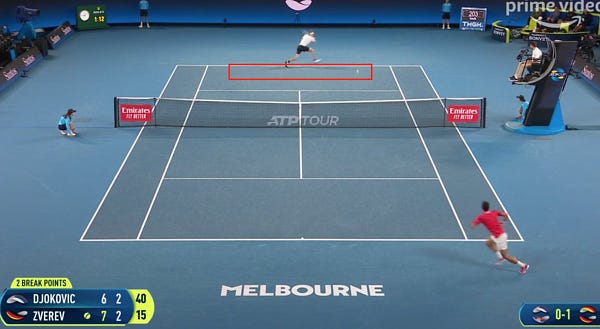
But Carreño Busta’s serve strategy made it just that bit harder for Djokovic to find that deep, central sweet spot on return as consistently as he would like.
The Spaniard did this mostly thanks to two key serves.
The slice 1st serve out wide to Djokovic’s forehand on the deuce side.
The kick 2nd serve out wide to Djokovic’s backhand on the AD side.
The 1st Serve
I can’t remember the last time I saw Carreño Busta hit these slice serve spots so well and so short/angled in the service box. On deuce points especially the serve came up extremely clutch:

Carreño Busta faced 13 deuces overall on his serve in this match.
He made 8 first serves out of those 13 points.
Out of those 8 first serves, he hit 7 slice first serves out wide, and won all 7 (as well as one T serve, also won).
Those are 7 times when he saved himself from more break point pressure, against the best returner in the game, with that excellent slice serve out wide.
This slice-1st-serve-out-wide supremacy was no better demonstrated than in the final game of the match with Carreño Busta serving for the bronze medal. Djokovic pushed the game to deuce and threatened to break back for one final comeback. But Carreño Busta’s slice serve out wide said ‘no’, three times in a row:

The 2nd serve
Djokovic was 0/6 on break points for the match. Four out of those six BP’s were saved on 2nd serves, kicked wide and high to the Djokovic backhand on the AD side (three in set 1, one in set 3):
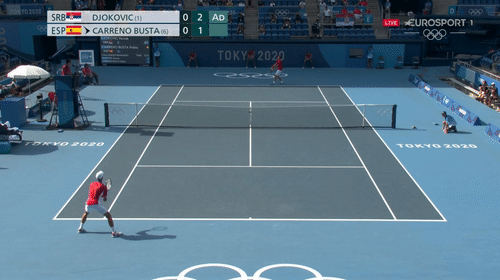
I particularly liked this 2nd serve strategy on the AD side because Djokovic redirects pace better than anyone, especially when the server goes into his body. By finding consistent width out wide and hitting quite safe speed-wise, but high-bouncing, kick serves, Carreño Busta forced Djokovic to generate his own pace and take the ball at uncomfortable heights. This is in marked contrast to Berrettini’s 2nd serve strategy against Djokovic at Wimbledon a couple of weeks ago, where Berrettini hit very fast body serves and got completely picked apart by Djokovic’s return. Obviously the grass and a higher bouncing hard court enable different sorts of serves, but that Wimbledon final and this bronze medal match serve as nice contrasts of serve strategy if you put them side by side (full analysis of Wimbledon final here).

Bronze? Feels like gold
Yes, this wasn’t the best version of Djokovic. And yes, if both were completely fresh the result could conceivably have been quite different. But as Nadal likes to remind us all — ‘if, if, if… doesn’t exist’ — and Carreño Busta has played Djokovic hard enough in the past to suggest that he has the requisite ability to hurt Djokovic regardless of where Novak’s own game is at. A thoroughly deserved win, and medal, for Carreño Busta, who continues to do the best thing he can in the face of various detractors who marginalize his hard court abilities. He just stays winning. And others will stay mad.
Carreño Busta when interviewed post-match:
It’s a Bronze medal but for me it’s like a Gold.”
His golden serving performance agrees.
— MW
If you have any questions on the above, let me know in the comments. No question is dumb.
I’ll see you on Thursday.
Twitter @MattRacquet
The Racquet goes out twice a week, a (free) topical piece every Thursday and a (paid) analysis piece every Sunday/Monday.
// Looking for more?
Top: Clive Brunskill/Getty
Bottom: Alexander Safonov/Anadolu Getty

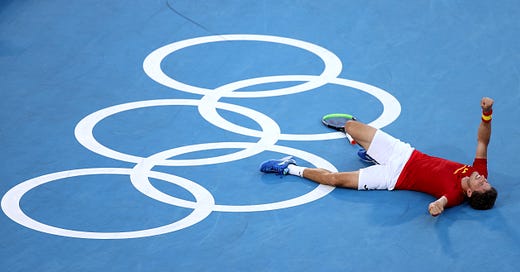


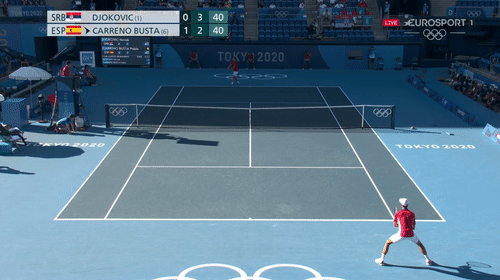
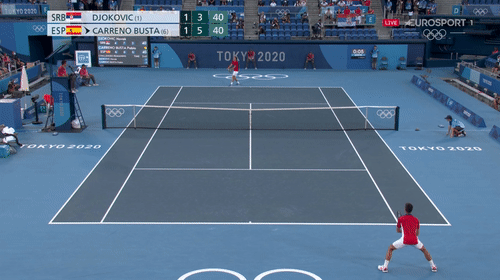
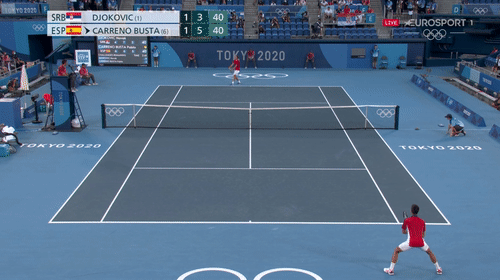


Hello Matthew. Truly moving to read about tennis players throughout these Tokyo Olympic games, for a wide range of exceptional reasons - thanks a lot for both your comments on Twitter & your articles, greatly appreciated. Your analysis on Carreño Busta's serving vs Djokovic was both very interesting and well documented, and also right on target imo. Perso unfortunately watched almost none of the Tokyo Games because of technical equipement breakdowns, but read loads about the Games. Unforgettable memories for tennis lovers/players at Tokyo, from Osaka's lighting the Olympic cauldron at the opening ceremony to Carreño Busta so deeply, and rightly so, happy with his bronze medal in single and Bencic's holding both her gold medal in single and silver medal in double in sheer disbelief. As for the tons of "if, if, if..." that are being and will keep being thrown all over the place for weeks if not years to come, not only is Nadal absolutely right that all those "if, if, if... don't exist" in reality, but as ESPN's Bodo reminded everyone a few months ago (in discussing Nadal's situation at RG this year, if memory serves), "if" is not only the longest 2-letter in English, but also its most useless word. PS: Loved your article on Biles and Osaka: Biles' determination & courage at the Tokyo Games were truly something for us all to witness.
This is a bit of a tangent, but I'm quite fond of using the "career statistics" pages around the end of big tournaments to understand the potential outcomes in the context of the players' careers, with particular reference to tennis' "big titles" (i.e. Slams + YEC + Olympic Gold + Tier 1s/Masters). One thing doing this highlights is how important taking these opportunities is - for most, they don't come along too often. I suppose I try to mentally figure out where the match or tournament might ultimately be put in the player's career story.
So for the Women's Singles final a quick look at Bencic's page (https://en.wikipedia.org/wiki/Belinda_Bencic_career_statistics) tells me she's won two Tier 1 titles and has made one GS Semi-Final (USO 2019). So Olympic Gold is the greatest achievement of her career to date, aged 24. It could very well presage greater victories to come - but given her history of injuries and the relative infrequency of deep runs at big tournaments (except 2019), there's (sadly!) a chance it doesn't. Hats off to her for handling the pressure and closing out. For Vondrousova, a younger player, there was perhaps a bit less pressure, but an Olympic medal is a huge achievement and sees her back at the sharp end of a big event for the first time since FO 2019.
And then looking at the men, obviously this is a disappointing week for Djokovic, but it'd probably get a paragraph at most in 5000 words on his career when he retires. For Zverev it's a big event, one of his biggest achievements to date (especially coming from set and a break down to beat ND), but you'd expect him to go on to greater things, given he's now won 6 big titles (4 Masters + Gold + YEC). For Khachanov it's clearly a significant event - his first big final since he won Paris in 2018. For Carreno-Busta, given his age and achievements to date, Bronze at Tokyo 2020 is likely to be a major career highlight. Thanks for taking the time to write up in detail how he did it!